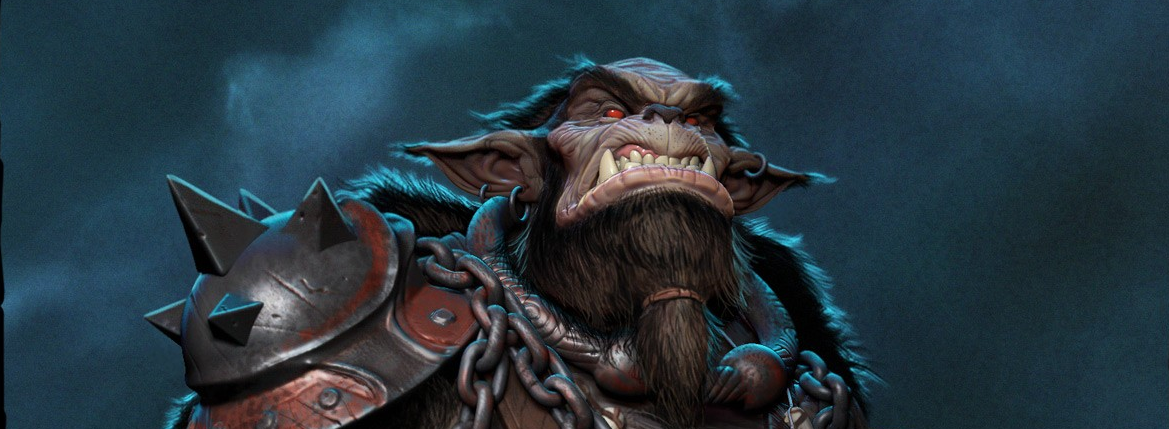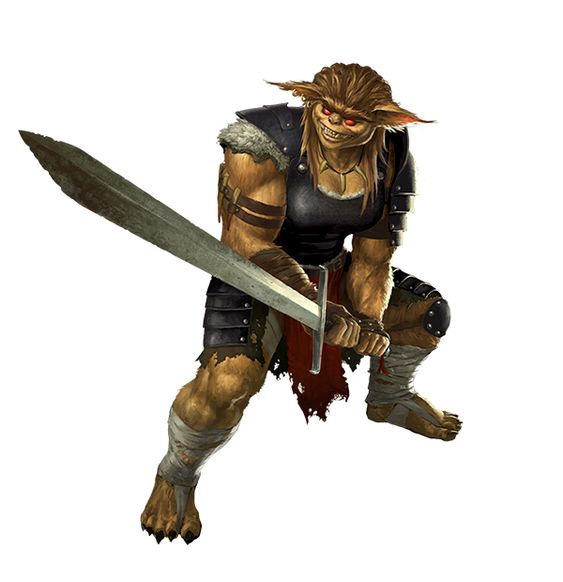Bugbear
Shiftless, savage layabouts
Bugbears feature in the nightmare tales of many races — great, hairy beasts that creep through the shadows as quiet as cats. If you walk alone in the woods, a bugbear will reach out of the bushes and strangle you. If you stray too far from the house at night, bugbears will scoop you up to devour you in their den. If a bugbear cuts off your head, your soul stays trapped inside, and the bugbears use your head to magically command all whom you once knew.
Lurid tales such as these have flowered from the seeds of truth. Bugbears do rely on stealth and strength to attack, preferring to operate at night. They do take the heads of enemy leaders, but they are no more likely to eat people indiscriminately than humans are. Bugbears aren’t likely to attack lone travelers or wandering children unless they clearly have something to gain by doing so. From the viewpoint of the rest of the world, their aggression and savagery are thankfully offset by their rarity and lethargy.
Basic Information
Anatomy
Bugbear hands and feet end in short claws like those of a bear, though they are not long or durable enough to be used in battle and are more suited to grooming fur.
Additional Information
Social Structure
Since bugbears aren’t a particularly fecund species, their overall population is small and spread over a wide area. Bugbears live in family groups that operate much like gangs. The individuals in a group typically number fewer than a dozen, consisting of siblings and their mates as well as a handful of offspring and an elder or two. A gang lives in and around a small enclosure, often a preexisting cave or an old bear den, and it might have supplementary dens elsewhere in its territory that it uses temporarily when it goes on long forays for food.
In good times, a bugbear gang is tight-knit, and its members cooperate well when hunting or bullying other creatures. But when the fortunes of a gang turn sour, the individuals become selfish, and might sabotage one another to remove opposition or exile weaker or unpopular members to keep the rest of the gang strong. Fortunately for the race as a whole, even young and elderly bugbears have the ability to survive alone in the wild, and the cast-off members of a gang might eventually catch on with a different group.
Facial characteristics
Bugbears are called such because of their faces, which have noses like bears. Their lower faces are very slightly muzzle-like and also have bearish qualities, including elongated upper and lower canines. They have goblinoid ears which are furred, and thick, furry brows.
Civilization and Culture
Average Technological Level
Generally speaking bugbears are content to use less sophisticated or well-crafted tools and gear than others might be. This stems from the bugbear innate laziness more than anything; why work hard to make a thing and take care of it when you can just replace it when it breaks?
History
Bugbears are descended from the Neanderthals that were designed to be spies and secret police. They evolved fur to help camouflage themselves and longer arms to better ambush unwary opponents. Because of this station, bugbears lack the honor that other orcs possess.
When they’re not in battle, bugbears spend much of their time resting or dozing. They don’t engage in crafting or agriculture to any great extent, or otherwise produce anything of value. They bully weaker creatures into doing their bidding so they can take it easy, a mentality that has been ingrained in them since they were feared as the secret police in ancient prehistory. When a superior force tries to intimidate bugbears into service, they will try to escape rather than perform the work or confront the foe. Even when subsumed into an orcish host and drawn into war, bugbears must often be roused from naps and bribed to get them to do their duties.
This indolence offers no clue to how vicious the creatures are. Bugbears are capable of bouts of incredible ferocity, using their muscular bodies to exact swift and ruthless violence. At their core, bugbears are ambush predators accustomed to long periods of inactivity broken by short bursts of murderous energy. Ferocious though they may be, bugbears aren’t built for extended periods of exertion.
Genetic Ancestor(s)
Scientific Name
Homo simplex insidia
Average Physique
Like all orcs, bugbears are naturally large and muscular. Bugbears are unique among orcs though in that their arms are longer by several inches than most humanoid species' arms are. If standing erect, a bugbear's fingertips would reach his or her knees.
Body Tint, Colouring and Marking
Bugbears have coarse fur-covered bodies, with fur colors ranging from tan to brown to reddish. Rarely a bugbear will have black or white fur. Their skin beneath the fur is generally yellowish or a reddish-brown.



Comments